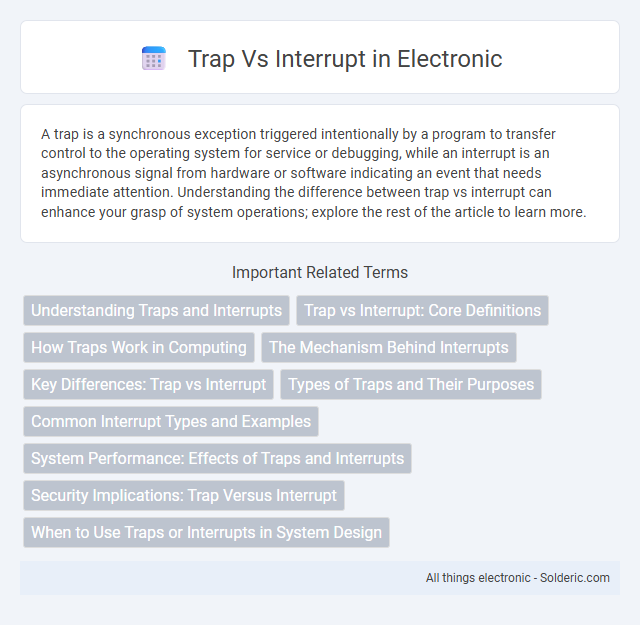A trap is a synchronous exception triggered intentionally by a program to transfer control to the operating system for service or debugging, while an interrupt is an asynchronous signal from hardware or software indicating an event that needs immediate attention. Understanding the difference between trap vs interrupt can enhance your grasp of system operations; explore the rest of the article to learn more.
Comparison Table
| Feature | Trap | Interrupt |
|---|---|---|
| Definition | Software-generated synchronous exception | Hardware-generated asynchronous event |
| Trigger | Program errors or system calls | External hardware signals |
| Control | Controlled by software | Controlled by hardware |
| Timing | Occurs at specific instruction execution | Can occur anytime asynchronously |
| Purpose | Handle exceptions and system calls | Handle input/output or hardware events |
| Handling | Causes a transfer to trap handler | Causes a transfer to interrupt handler |
| Examples | Division by zero, system call | Keyboard input, timer |
Understanding Traps and Interrupts
Traps and interrupts are essential mechanisms for managing control flow in computer systems, with traps representing synchronous exceptions triggered by the executing program, while interrupts are asynchronous signals from hardware devices demanding immediate attention. Understanding traps involves recognizing how they enable error handling and system calls by halting the CPU to execute a specific handler, whereas interrupts allow external events to be serviced without waiting for the current program to finish. Your system's responsiveness and stability depend on efficiently distinguishing and handling these two types of events.
Trap vs Interrupt: Core Definitions
A trap is a synchronous event triggered by the processor when executing an instruction, often used to handle exceptions or system calls, whereas an interrupt is an asynchronous signal from external hardware indicating an immediate attention requirement. Traps originate internally, allowing the operating system to intervene during program execution, while interrupts come from external devices, pausing current activities to address urgent tasks. Understanding the distinction between traps and interrupts enables you to better manage system responses to both software and hardware events efficiently.
How Traps Work in Computing
Traps in computing are synchronous interrupts triggered by exceptional conditions or specific instructions, causing the processor to pause normal execution and transfer control to a predefined trap handler. These handlers operate within the operating system to address errors, such as division by zero or invalid memory access, ensuring system stability. By capturing traps promptly, the system can manage faults efficiently and maintain operational integrity.
The Mechanism Behind Interrupts
The mechanism behind interrupts involves hardware signals that temporarily halt the CPU's current execution flow to address urgent tasks, enabling real-time responsiveness. Unlike traps, which are synchronous and caused by software anomalies or explicit instructions, interrupts are asynchronous events triggered by external devices or hardware timers. Understanding this distinction helps you design efficient programs that manage system resources and respond swiftly to critical hardware events.
Key Differences: Trap vs Interrupt
Traps are synchronous exceptions generated by the processor due to errors or specific instructions, while interrupts are asynchronous signals from external devices requesting immediate attention. Traps typically occur within the executing program context, enabling the system to handle conditions like invalid operations or system calls, whereas interrupts can occur at any time, regardless of the current instruction execution. The handling routine for traps and interrupts differs in priority and source, with traps being internally initiated and interrupts externally triggered.
Types of Traps and Their Purposes
Traps are synchronous exceptions triggered by the CPU when executing specific instructions or encountering errors, classified mainly as software traps, hardware traps, and system calls, each serving unique purposes such as debugging, error handling, or requesting OS services. Software traps help in debugging and managing errors like division by zero, hardware traps respond to events like illegal memory access, and system calls allow your programs to request operating system functions securely. Understanding the distinct types of traps enhances efficient handling of exceptions and optimizes system performance.
Common Interrupt Types and Examples
Common interrupt types include hardware interrupts like timer interrupts, keyboard interrupts, and I/O device interrupts, which signal the CPU to handle external events immediately. Software interrupts, or traps, are triggered by the execution of specific instructions such as system calls or exceptions like division by zero, enabling controlled execution of operating system services. Edge-triggered and level-triggered interrupts represent signaling mechanisms that guide the CPU's response based on signal changes or levels.
System Performance: Effects of Traps and Interrupts
Traps and interrupts significantly influence system performance by managing how the CPU handles events and exceptions. Traps, triggered by software conditions, allow precise control flow and error handling with minimal latency, whereas interrupts enable asynchronous hardware event processing, potentially introducing context-switching overhead. Optimizing your system requires balancing trap frequency to minimize performance impact while ensuring interrupts are efficiently prioritized to maintain responsiveness.
Security Implications: Trap Versus Interrupt
Traps and interrupts differ significantly in their security implications, as traps are synchronous, software-generated exceptions that occur due to specific, predictable events like illegal instructions or system calls, allowing for controlled handling within your program. Interrupts are asynchronous, hardware-generated signals that respond to external events, making them more susceptible to timing attacks or unauthorized external manipulation. Understanding these differences enables you to design secure systems that effectively manage privilege escalation and prevent exploitation of asynchronous vulnerabilities.
When to Use Traps or Interrupts in System Design
Traps are best used for handling software exceptions and system calls, where the CPU intentionally transfers control to the OS for tasks like debugging or I/O operations. Interrupts are optimal for responding to asynchronous hardware events such as keyboard input or timer signals, enabling immediate attention without busy-waiting. Choosing traps for synchronous events and interrupts for asynchronous signals ensures efficient and predictable system design.
trap vs interrupt Infographic

 solderic.com
solderic.com